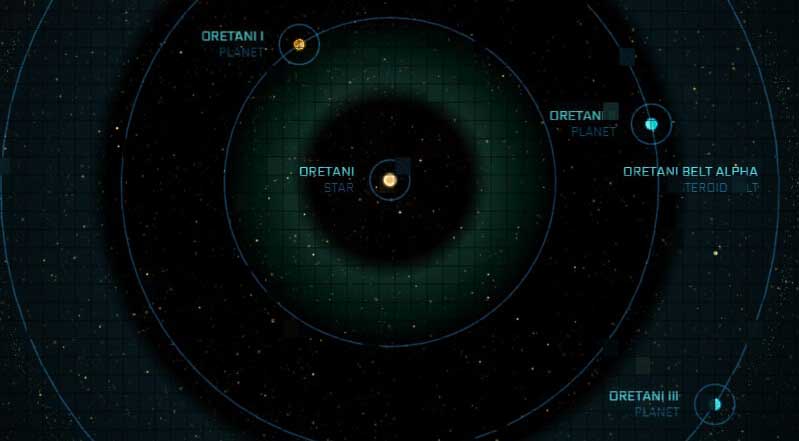Today, the Oretani system is remembered more as a legend than a reality. Discovered during the halcyon days of our expansion into the stars, the system shocked Humanity after the only jump point connecting it to the known universe collapsed and never reformed. This tragic incident marooned thousands of settlers. To this day, despite many hypotheses, the truth of their fate has yet to be learned.
Though currently impossible to visit, we here at Galactic Guide deem it worthy of coverage. Both as a way to honor those tragically lost and to help distinguish the fact from the wild fiction surrounding the system.
EXPANSIONIST ERA
Humanity’s optimism over settling space peaked in the 25th century. A confluence of social factors and political pressures made space the millennium’s ‘manifest destiny’. In fact, many deemed it not only natural but necessary to move into the stars. Earth’s diminishing natural resources and massive overpopulation powered the development of space exploration and ultimately terraforming technology. Nick Croshaw’s discovery of jump points opened a doorway into unimaginable scores of potential resources.
Amidst this unbridled optimism, Micah Zahir found himself out of work in the Ferron system. He earned his living as a mining scan operator on Asura, but bureaucratic red tape and a brewing controversy over the distribution of mining rights stifled opportunities for contractors. Recent upgrades to his ship’s scanner and radar had left his funds depleted, so Zahir picked up lower paying gigs as an escort for supply convoys. One such run ventured off the traditional shipping lanes after the convoy leader received intel that outlaws were targeting their usual route. Working the radar with extra care, Zahir picked up a strange ping. A series of scans quickly eliminated the possibility that it was another ship before the anomaly vanished. The convoy proceeded to its destination, but the strange signature peaked Zahir’s curiosity. Later, he returned alone and undertook a thorough investigation that uncovered the fateful jump point into Oretani.
In 2481, Zahir made multiple trips to Oretani to thoroughly scan it. When he eventually reported his discovery, Zahir named the system after his favorite ship from the 2464 blockbuster vid, Blast Caster. He used the windfall from the sale to the UNE to purchase real estate on Selene. When Zahir died in 2577, he had become one of the largest landowners in the Vega system. His obituary in the Selene Sentinel praised his business acumen, philanthropy, and described him as a ‘truly modern self-made man whose legacy to the community outlives the system he discovered’.
TERRA REFORMERS
Oretani’s discovery sparked excitement. It contained six planets, two of which had been cleared as potentially habitable, and a mineral-rich asteroid belt. Thanks to the UNE’s expansion initiative and numerous technological advances, an oversaturation of terraforming corporations flocked for government contracts. The UNE awarded Turiya Terraforming the opportunity to make Oretani II habitable. Commentators deemed it a politically safe and progressive choice. Though the company had never terraformed a planet, CEO Adriana Bratanek stacked Turiya’s executive ranks with experienced industry insiders and gained the backing of enough prominent investors to immediately put their plans in motion.
Bratanek embodied the ambition and optimism of the era. She believed that terraforming should not be the precursor to planetary habitation, but its initial stage. Besides paying a premium for experienced terraformers, she offered workers and their families free housing on space stations within the system on the condition that they move to the planet once it was habitable. Bratanek argued that the initiative would increase worker morale and the quality of their work, since they were literally creating their future home.
Aided by a series of UNE job fairs and an expansive marketing campaign, thousands of workers and their families jumped at the opportunity to help terraform the system. The promise of being the first settlers on a pristine, new homeworld made the years living aboard a space station worth it. Industry analysts watched with great interest as many were concerned that it would create added costs to attract workers and dramatically cut into their bottom line. Others believed that if the changes lead to happier employees and fewer accidents, then it was a positive step.
The first terraforming machines above Oretani II became active in 2483. Nearly one year later, the operation was firing on all cylinders and the initial results were better than expected. Bratanek appeared before a UNE terraforming commission to brag about Turiya being ahead of schedule and under budget. The public heard nothing but positive news about Oretani thanks to an aggressive media strategy employed by Turiya, but industry insiders were bothered by reports trickling out of the system. There were stories of occasional food rationing at some space stations due to delayed shipments, which then created a burgeoning black market. Other families felt swindled when they learned that Oretani II was an ocean world – a fact that certain Turiya recruiters failed to make clear in economically depressed areas of the Empire. Suddenly, the dream of homesteading was replaced by the reality of living on a platform amidst a vast ocean.
In an effort to undercut the growing negative press, Bratanek invited a handful of journalists to tour the system and Turiya’s operations with her. On April 11, 2485, two days after they entered the system, the jump point connecting Oretani to Ferron suddenly collapsed, cutting off all connection to the rest of civilization.
NO WAY HOME
The loss of Oretani struck a heavy blow to Humanity’s psyche. The idea of easy, confident expansion across the stars was damaged. When news first broke of Oretani’s loss, many didn’t know such a thing was possible. Jump points were known to be unstable but not disappear completely.
The UNE dispatched a massive fleet of scanning and scientific ships into Ferron hoping to reopen the lost jump point or discover a new one. Humanity’s best and brightest minds offered their help, and companies throughout the universe donated credits and supplies to the cause. The most brilliant minds in the UNE grappled with a cosmic question: can you open a collapsed jump point? Yet, all of their efforts were in vain, as the frantic search settled into a systematic exploration of options. Days turned to weeks, then months, and though the story still sat on everyone’s mind, the realization that the system might be gone for good slowly sank in. Eventually, the UNE reluctantly reduced the resources dedicated to rediscovering Oretani and installed an extensive array of sensor beacons near the former jump point. A fleet of military pathfinders was also deployed to the system and assigned to patrol the region on a regular basis.
The fear that this would happen again kept settlers from venturing further into the stars, and systems began to stockpile supplies to make sure that they could self-sustain should the unthinkable happen. The population was shaken by this development too. Systems with multiple jump points saw a noticeable increase in population, and there was increased immigration back to Earth – the exact opposite of what the UNE hoped to accomplish.
To this day, the UEE government maintains an array of sensors and has pathfinders patrolling that sector of Ferron in the hopes that the jump point will reopen. Centuries later there is still no good news to report. In fact, all accounts of people escaping the system or even transmitting messages from it have been confirmed as hoaxes. The most famous of these being the so-called ‘Oretani Beacon’, claimed to have been found by Erling Bradford in 2506. The recording of a shaky voice proclaiming that she was an Oretani survivor was later proven to be made by Erling and his niece. Regardless, there are some who still believe that the plea is genuine evidence that contact with the system is possible.
Despite the desire to know what happened to the inhabitants of Oretani, the best any of us can do is guess. Many hope that if the original jump point doesn’t reappear, then another will be found back into the system, so that we may finally discover the fate of those cut off so long ago.


